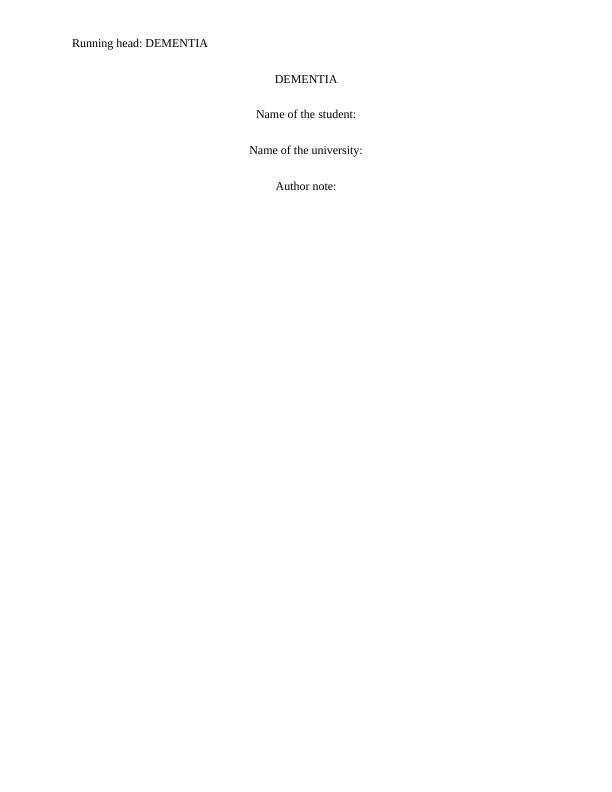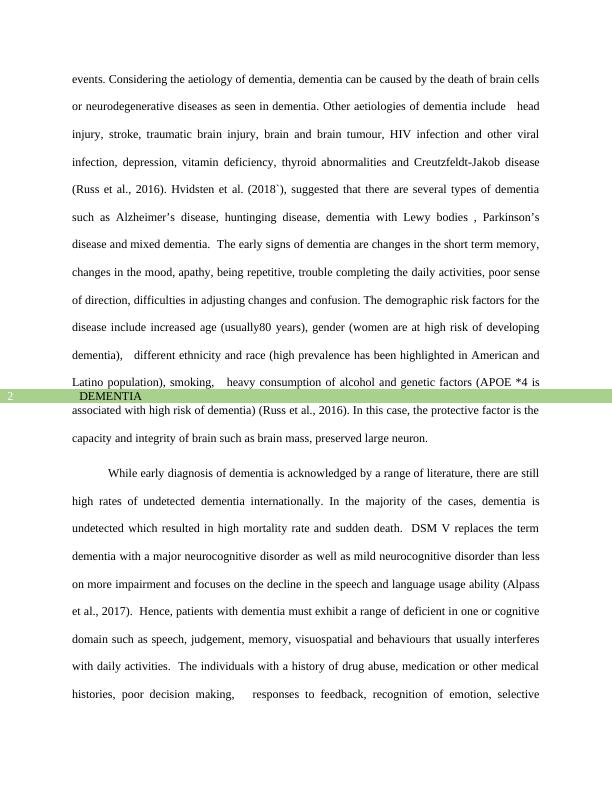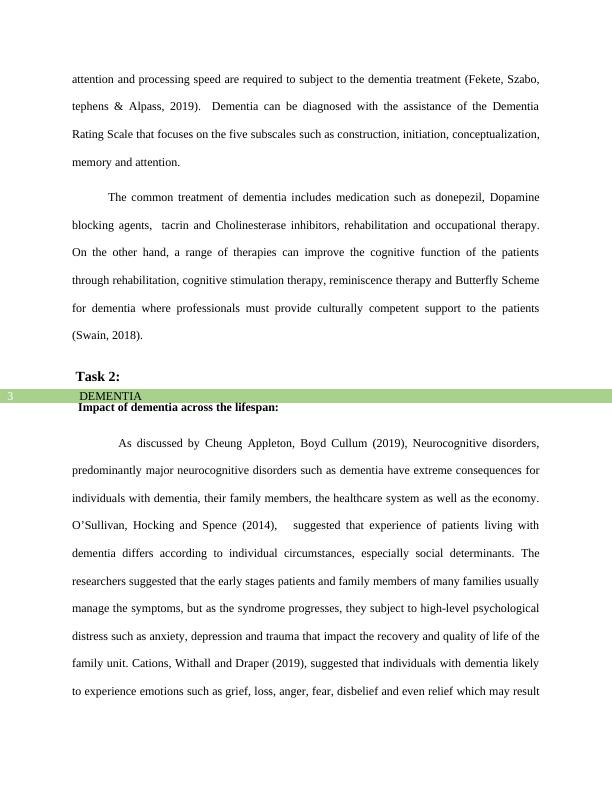Maori inhabits in New Zealand
Added on 2022-08-14
15 Pages4205 Words19 Views
Running head: DEMENTIA
DEMENTIA
Name of the student:
Name of the university:
Author note:
DEMENTIA
Name of the student:
Name of the university:
Author note:

DEMENTIA1
Introduction:
In the recent era, Dementia has been framed as a neurodegenerative condition highly
associated with ageing, especially amongst those over 80 years of age. Dyall (2014), suggested
that For Maori inhabits in New Zealand dementia is not fundamentally associated with age but is
individual histories within this country, and the social determinants of health for populations
from A recent report Alzheimer new Zealand suggested that Dementia affected more than
70000 individuals and expected to increase triple by 2050. The recent report of dementia
suggested that the prevalence of dementia in the population of New Zealand was approximately
62,287 individuals in 2016, accounting for almost 1.3% of the total population of New Zealand.
This data suggested that dementia has increased by 29% over 5 years from 2011 where
population living with dementia include 48, 182 individuals (Payman, Yates & Cullum, 2018).
The purpose of this essay to demonstrate a range of principles and environment that support the
recovery of the individuals of New Zealand, including Whanua and discuss the therapeutic
approaches to reduce the mental health issues of the individuals. This paper will discuss
aetiology, diagnosis criteria and treatment in task 1, the potential impact on the lifespan in task 2,
principles that support recovery in task 3, two strategies that support recovery in task 4 and
therapeutic nursing intervention in task 5 in following paragraphs.
Discussion:
Task 1:
For this task, the chosen health condition is dementia. Martinez-Ruiz et al. (2016), suggested
dementia is a collecting term for describing a range of symptoms such as cognitive declined,
limited social skills confusion, poor concentration and difficulties in remembering specific recent
Introduction:
In the recent era, Dementia has been framed as a neurodegenerative condition highly
associated with ageing, especially amongst those over 80 years of age. Dyall (2014), suggested
that For Maori inhabits in New Zealand dementia is not fundamentally associated with age but is
individual histories within this country, and the social determinants of health for populations
from A recent report Alzheimer new Zealand suggested that Dementia affected more than
70000 individuals and expected to increase triple by 2050. The recent report of dementia
suggested that the prevalence of dementia in the population of New Zealand was approximately
62,287 individuals in 2016, accounting for almost 1.3% of the total population of New Zealand.
This data suggested that dementia has increased by 29% over 5 years from 2011 where
population living with dementia include 48, 182 individuals (Payman, Yates & Cullum, 2018).
The purpose of this essay to demonstrate a range of principles and environment that support the
recovery of the individuals of New Zealand, including Whanua and discuss the therapeutic
approaches to reduce the mental health issues of the individuals. This paper will discuss
aetiology, diagnosis criteria and treatment in task 1, the potential impact on the lifespan in task 2,
principles that support recovery in task 3, two strategies that support recovery in task 4 and
therapeutic nursing intervention in task 5 in following paragraphs.
Discussion:
Task 1:
For this task, the chosen health condition is dementia. Martinez-Ruiz et al. (2016), suggested
dementia is a collecting term for describing a range of symptoms such as cognitive declined,
limited social skills confusion, poor concentration and difficulties in remembering specific recent

DEMENTIA2
events. Considering the aetiology of dementia, dementia can be caused by the death of brain cells
or neurodegenerative diseases as seen in dementia. Other aetiologies of dementia include head
injury, stroke, traumatic brain injury, brain and brain tumour, HIV infection and other viral
infection, depression, vitamin deficiency, thyroid abnormalities and Creutzfeldt-Jakob disease
(Russ et al., 2016). Hvidsten et al. (2018`), suggested that there are several types of dementia
such as Alzheimer’s disease, huntinging disease, dementia with Lewy bodies , Parkinson’s
disease and mixed dementia. The early signs of dementia are changes in the short term memory,
changes in the mood, apathy, being repetitive, trouble completing the daily activities, poor sense
of direction, difficulties in adjusting changes and confusion. The demographic risk factors for the
disease include increased age (usually80 years), gender (women are at high risk of developing
dementia), different ethnicity and race (high prevalence has been highlighted in American and
Latino population), smoking, heavy consumption of alcohol and genetic factors (APOE *4 is
associated with high risk of dementia) (Russ et al., 2016). In this case, the protective factor is the
capacity and integrity of brain such as brain mass, preserved large neuron.
While early diagnosis of dementia is acknowledged by a range of literature, there are still
high rates of undetected dementia internationally. In the majority of the cases, dementia is
undetected which resulted in high mortality rate and sudden death. DSM V replaces the term
dementia with a major neurocognitive disorder as well as mild neurocognitive disorder than less
on more impairment and focuses on the decline in the speech and language usage ability (Alpass
et al., 2017). Hence, patients with dementia must exhibit a range of deficient in one or cognitive
domain such as speech, judgement, memory, visuospatial and behaviours that usually interferes
with daily activities. The individuals with a history of drug abuse, medication or other medical
histories, poor decision making, responses to feedback, recognition of emotion, selective
events. Considering the aetiology of dementia, dementia can be caused by the death of brain cells
or neurodegenerative diseases as seen in dementia. Other aetiologies of dementia include head
injury, stroke, traumatic brain injury, brain and brain tumour, HIV infection and other viral
infection, depression, vitamin deficiency, thyroid abnormalities and Creutzfeldt-Jakob disease
(Russ et al., 2016). Hvidsten et al. (2018`), suggested that there are several types of dementia
such as Alzheimer’s disease, huntinging disease, dementia with Lewy bodies , Parkinson’s
disease and mixed dementia. The early signs of dementia are changes in the short term memory,
changes in the mood, apathy, being repetitive, trouble completing the daily activities, poor sense
of direction, difficulties in adjusting changes and confusion. The demographic risk factors for the
disease include increased age (usually80 years), gender (women are at high risk of developing
dementia), different ethnicity and race (high prevalence has been highlighted in American and
Latino population), smoking, heavy consumption of alcohol and genetic factors (APOE *4 is
associated with high risk of dementia) (Russ et al., 2016). In this case, the protective factor is the
capacity and integrity of brain such as brain mass, preserved large neuron.
While early diagnosis of dementia is acknowledged by a range of literature, there are still
high rates of undetected dementia internationally. In the majority of the cases, dementia is
undetected which resulted in high mortality rate and sudden death. DSM V replaces the term
dementia with a major neurocognitive disorder as well as mild neurocognitive disorder than less
on more impairment and focuses on the decline in the speech and language usage ability (Alpass
et al., 2017). Hence, patients with dementia must exhibit a range of deficient in one or cognitive
domain such as speech, judgement, memory, visuospatial and behaviours that usually interferes
with daily activities. The individuals with a history of drug abuse, medication or other medical
histories, poor decision making, responses to feedback, recognition of emotion, selective

DEMENTIA3
attention and processing speed are required to subject to the dementia treatment (Fekete, Szabo,
tephens & Alpass, 2019). Dementia can be diagnosed with the assistance of the Dementia
Rating Scale that focuses on the five subscales such as construction, initiation, conceptualization,
memory and attention.
The common treatment of dementia includes medication such as donepezil, Dopamine
blocking agents, tacrin and Cholinesterase inhibitors, rehabilitation and occupational therapy.
On the other hand, a range of therapies can improve the cognitive function of the patients
through rehabilitation, cognitive stimulation therapy, reminiscence therapy and Butterfly Scheme
for dementia where professionals must provide culturally competent support to the patients
(Swain, 2018).
Task 2:
Impact of dementia across the lifespan:
As discussed by Cheung Appleton, Boyd Cullum (2019), Neurocognitive disorders,
predominantly major neurocognitive disorders such as dementia have extreme consequences for
individuals with dementia, their family members, the healthcare system as well as the economy.
O’Sullivan, Hocking and Spence (2014), suggested that experience of patients living with
dementia differs according to individual circumstances, especially social determinants. The
researchers suggested that the early stages patients and family members of many families usually
manage the symptoms, but as the syndrome progresses, they subject to high-level psychological
distress such as anxiety, depression and trauma that impact the recovery and quality of life of the
family unit. Cations, Withall and Draper (2019), suggested that individuals with dementia likely
to experience emotions such as grief, loss, anger, fear, disbelief and even relief which may result
attention and processing speed are required to subject to the dementia treatment (Fekete, Szabo,
tephens & Alpass, 2019). Dementia can be diagnosed with the assistance of the Dementia
Rating Scale that focuses on the five subscales such as construction, initiation, conceptualization,
memory and attention.
The common treatment of dementia includes medication such as donepezil, Dopamine
blocking agents, tacrin and Cholinesterase inhibitors, rehabilitation and occupational therapy.
On the other hand, a range of therapies can improve the cognitive function of the patients
through rehabilitation, cognitive stimulation therapy, reminiscence therapy and Butterfly Scheme
for dementia where professionals must provide culturally competent support to the patients
(Swain, 2018).
Task 2:
Impact of dementia across the lifespan:
As discussed by Cheung Appleton, Boyd Cullum (2019), Neurocognitive disorders,
predominantly major neurocognitive disorders such as dementia have extreme consequences for
individuals with dementia, their family members, the healthcare system as well as the economy.
O’Sullivan, Hocking and Spence (2014), suggested that experience of patients living with
dementia differs according to individual circumstances, especially social determinants. The
researchers suggested that the early stages patients and family members of many families usually
manage the symptoms, but as the syndrome progresses, they subject to high-level psychological
distress such as anxiety, depression and trauma that impact the recovery and quality of life of the
family unit. Cations, Withall and Draper (2019), suggested that individuals with dementia likely
to experience emotions such as grief, loss, anger, fear, disbelief and even relief which may result

End of preview
Want to access all the pages? Upload your documents or become a member.
Related Documents
Systematic Review in Neurosciencelg...
|19
|4643
|30
The Effect of Nutrition in Dementia Patients in UKlg...
|11
|2822
|229
Clinical Update on Dementia in Australialg...
|14
|3768
|345
Dementia: Types, Symptoms, Diagnosis and Treatmentlg...
|10
|3024
|306
Dementia: Understanding the Symptoms, Risk Factors, and Managementlg...
|7
|4666
|172
Understanding Dementia: Types, Symptoms, Epidemiology, Treatment and Effectslg...
|8
|2303
|388
